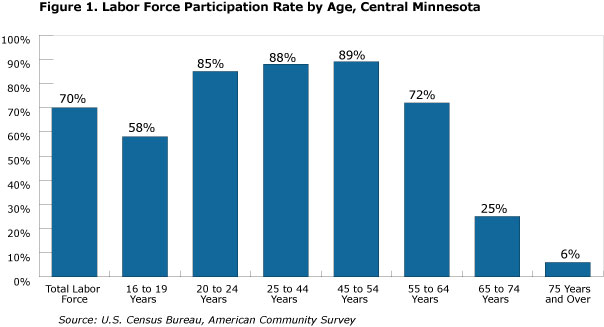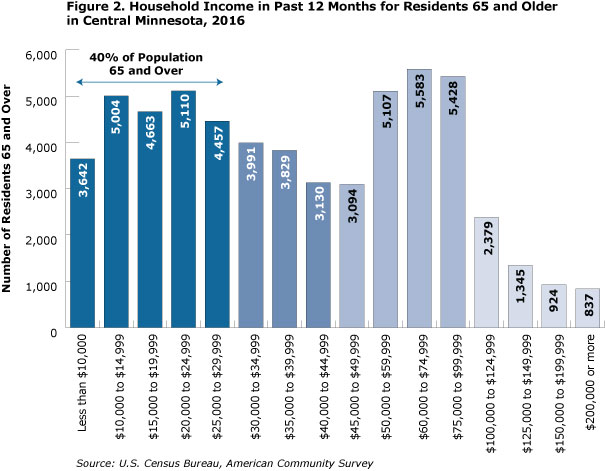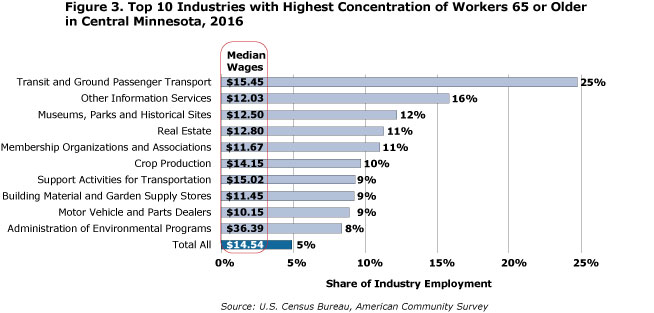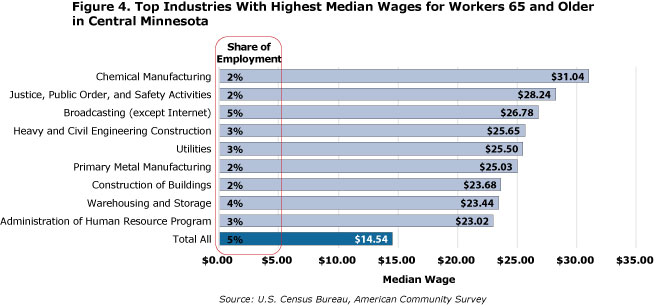by Luke Greiner
November 2018
With a tightening job market and labor force that is projected to grow much more slowly in the future as exemplified by a record number of job openings posted in 2018, businesses in Central Minnesota are struggling to find available workers. At the same time more than one in seven people in Central Minnesota are now 65 or older, and that portion of the population is expected to grow much more quickly in the future. Employers are in search of workers, and many older residents have a desire to continue working. But the fit needs to be right, which begs the question: will older workers stay in the labor force longer? Understanding some of the dynamics and challenges facing potential workers in this age category can help inform strategies to maximize the incentive and enjoyment for people to work into their golden years.
Decisions about work and retirement are facing many of the more than 105,000 residents in the region who are older than 64. Factors such as out-of-pocket health care costs, retirement account balances, health condition, and quality of work are just some of the considerations that impact when and why people retire. Regardless of the reason(s) for retiring, as larger numbers of employees become eligible for social security retirement benefits, employers in central Minnesota and across the country are holding their breath.
According to the 2017 Federal Reserve Report on the Economic Well-Being of U.S. Households, nationally half of retirees retired before age 62 and an additional one-quarter retired between the ages of 62 and 64. The most common factors for choosing when to retire were the desire to do things other than work and to spend time with family1 (see Table 1).
| Table 1. Reasons Affecting Retirement by Age Retired | ||||
|---|---|---|---|---|
| Reason | Don't Know | 61 or Earlier | 62-65 | 65+ |
| Wanted to do other things | 48% | 56% | 62% | 61% |
| Wanted to spend more time with family | 54% | 52% | 57% | 57% |
| Poor health | 63% | 39% | 31% | 27% |
| Family responsibilities | 52% | 33% | 33% | 30% |
| Didn't like the work | 32% | 30% | 28% | 26% |
| Forced to retire or lack of available work | 38% | 23% | 26% | 25% |
| Note: Among retirees, respondents can select multiple answers. | ||||
| Source: 2017 Federal Reserve Survey of Household Economics and Decisionmaking | ||||
Although retirees in Central Minnesota might be marching to their own drummers rather than following the national trends, it's possible that a large number of potential workers in the region have retired because they didn't like the work or because they were forced to retire by a lack of available work. The latter seems unlikely in the current tight job market, however. Depending on their age, between a quarter and a third of retirees identified with those two reasons.
Despite dramatic changes in the health of the economy since 2011, the labor force participation rate has remained unchanged since 2011 for residents 65 years and older in Central Minnesota. The labor force participation rate for adults begins to decline for people 55 to 64 years old, dropping to 72 percent from 89 percent for 45 to 54 year olds. But the decline is more significant for the next older cohort where it drops to a quarter for 65 to 74 year olds in Central Minnesota who participate in the labor force. The rate is slightly lower in Central Minnesota than the 27 percent statewide (see Figure 1).

The slowing labor force growth comes in part from the expansion of the older population, as more people beyond age 64 will start to exhibit the relatively low participation rates of this group, which will pull down the overall participation rate of the region. Counties like Renville that are noticeably older are already experiencing this phenomenon. On the other hand, if the participation rate for workers aged 65 to 74 increased to 30 percent, Central Minnesota could see an additional 2,691 workers, an amount equal to roughly half of the overall labor force growth in the region from 2016 to 2017.
According to household income data, the incentive to work beyond age 65 might be high for many in Central Minnesota, possibly of necessity. Using DEED's Cost Of Living tool, the basic needs cost for a partnered couple over 50 with no kids is just over $40,000 per year. However, 53 percent of current residents aged 65 years or older have a household income less than that amount.
It should be noted that the cost for a single person to live alone is lower at $32,196 in 2018, yet more than 40 percent of householders aged 65 years or older have a household income that is less than that basic-needs cost (see Figure 2).

DEED's Quarterly Employment Demographics provides detailed wages, hours worked, and share of jobs held by workers of different ages. Annual data show that workers 65 or older held 5 percent of the jobs in Central Minnesota, although some segments of the economy have much higher concentrations. For instance, in the Transit and Ground Passenger Transportation industry one-quarter of jobs are held by workers 65 or older (see Figure 3).

The median wage earned for older workers in that industry is only about 90 cents higher than the median earned by all workers 65+ years, so it's unlikely that premium wages is the largest force at play in the high concentration. What's probably most appealing to older workers is the limited hours and flexible work schedules offered by transit companies. Many workers leave other careers to find enjoyable post-retirement employment as a driver for a local transit or bus company. The data show that despite increasing demand for transportation services, the median hours worked by workers 65 or older in the Ground Transportation industry is actually in decline. This bucks the trend in the broader economy where older workers are putting in more hours than ever before.
According to Sandie Westergren, the human resources director at WACOSA, a Central Minnesota based non-profit that provides services to individuals with disabilities and employs large numbers of drivers, "The need and demand for drivers continues to increase, so accommodating workers' preferences means offering generous flexibility, to the extent where workers can sometimes pick their hours or shifts. Many older workers are looking for flexibility and enjoyment out of a job, so offering what they want is just part of our strategy to recruit and retain older workers."
When asked about the declining number of hours worked by older workers in the transit industry, Westergren said that "It makes perfect sense that hours could be decreasing in an effort to increase the number of folks who might be interested in working." In other words, they are also seeing a trend of more older workers working fewer hours.
On the other end of the spectrum, industries that show the highest median wages for older workers employ them at much lower rates. Workers 65 and older have a median hourly wage of $31.04 in the Chemical Manufacturing Industry (Including Ethanol Production) in Central Minnesota, but they hold just 2 percent of the jobs in the industry. Considering the high wage and low availability of part-time openings at manufacturing plants, most of the older workers who are employed by the industries in Figure 4 are not post-retirement workers in a second career.
Comparing the median hours worked for employees 65 or older in Figure 3 and Figure 4 underscores the differences in how work-life balance might impact an older worker's decision to remain employed or regain employment after retirement. The average of the median hours worked for employees 65+ years in Figure 3 amounts to 12.5 hours per week, while the older workers at industries in Figure 4 typically put in over 30 hours per week.

With the reasons to retire heavily focused on dedicating time to other things and family, offering flexibility and shorter shifts appears not only to work to attract or keep older workers, but a part-time job could even be the "other thing" some retirees look for after "retirement". Increasing employment opportunities that fit well with older workers not only benefits those seeking to stay engaged in the labor force, but it can also help ease the labor crunch many employers are struggling with.
Report on Economic Well-being.
1Research is inconclusive about whether families want to spend more time with retirees.